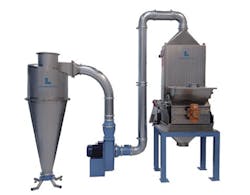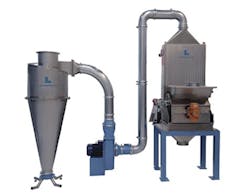Pellet-containment methods advance
Waste is the enemy, regardless of whether it refers to loss of time, money or material. Preventing waste can be especially challenging for processors, however, because they not only need to worry about waste that occurs within the factory walls, they also need to worry about keeping their materials from escaping into the environment.
Fortunately, the industry has made strides toward minimizing waste, regardless of where it occurs. Machinery manufacturers have addressed a number of challenges with their recent offerings, with devices for pellet containment and contamination prevention.
ADG Solutions
ADG Solutions recently signed a marketing agreement to distribute equipment that can help U.S. processors avoid pellet loss during silo loading. Ideal for molders and extruders that purchase resin in gaylords or bulk bags, the equipment is manufactured by Lorandi Silos, Brescia, Italy, and is configured for American customers by ADG Solutions.
Silo-loading systems consist of a material infeed hopper and compressor with rotary valve. Incoming resin can be dumped into the system by gaylord tippers or from bulk bags hung from an integral frame. From there, resin is conveyed pneumatically to holding bins or silos. The loaders can handle up to 55,000 pounds per hour. The systems are flexible and can be moved easily with a forklift to different locations in a plant.
"We have customers that receive as many as 500 gaylords of polycarbonate and PMMA [polymethyl methacrylate] every week," said Sandy Guthrie, president of ADG Solutions. "They need a way to transfer that resin to silos without spilling."
For companies that need to handle multiple bulk bags, discharge stations can be installed to accommodate half a dozen or more sacks at a time. A rolling winch, mounted on a cantilevered beam, is used to lift each bag and slide it into position for discharge into the infeed hopper of the silo loading system.
"However, because no system is 100 percent, it is inevitable that some pellets spill or otherwise become contaminated with unwanted debris," Guthrie said. "You don't want to simply throw it away, so you need a system to clean it, and that's where the T-Cleaner comes in."
The T-Cleaner separates dirt, dust, paper, glass and even rocks from plastic pellets or regrind based on their bulk densities. Contaminated material enters the T-Cleaner, where it is agitated.
When lightweight contamination is involved, pellets fall out of the bottom of the unit, while lighter-weight components (dust or paper) are blown up and out the top. When resin is contaminated with heavy items like rocks or glass, the setup is reversed, so that the heavy contaminants fall out the bottom of the T-Cleaner, while the clean resin exits at the top.
Two regulators allow control over the T-Cleaner separator's airflow, depending on the relative weight of the different constituents in the source material. The maximum throughput is 18,000 pounds per hour for pellets and 9,000 pounds per hour for flake.
Conair Group
The newest feature available on some True-Blend blenders from Conair Group is a conical mixing chamber that eliminates "dead spots" where pellets tend to get hung up. This new configuration is ideal for critical blends where the addition rate is under 1 percent.
"At these low rates," explained Alan Landers, Conair blending product manager, "the loss of just a few pellets of color or additive could impact the quality of the finished product and result in increased scrap. With the conical mixing chamber, however, there are really no corners where pellets can hang up. Everything that goes into the mixer will thoroughly blend and completely evacuate for improved quality and reduced plastic waste."
The conical mixing chamber is now available on Conair's mid-size blenders, the TB250, TB500 and TB900.
TrueBlend blenders have additional features that prevent pellet loss, including a completely sealed housing that surrounds the mixing chamber.
Conair also introduced a new SB3 blender control last year; it has onboard memory that can store up to 3,000 blend recipes and 4,000 resin names, reducing the likelihood of incorrect blender settings and the resulting material waste. The SB3 control operates with Microsoft SQL, a database system that can track the resin, regrind, color and additives that are being processed for better control over all materials.
Spills around blenders are a common sight; granulators often are a site for the same problems. To address this issue, Conair is reconfiguring its entire granulator product line to incorporate new and improved feeding and material-handling capabilities.
For example, dumping the granulator catch bin manually is inefficient and often results in spillage, so all Conair granulators now are available with the features necessary for continuous, automatic regrind evacuation. Options include:
• Compressed-air evacuation, in which a pick-up tube with a venturi is used to pull granulate out of the catch bin and push it to a gaylord or holding bin.
• Vacuum evacuation, in which the pick-up tube is connected to a self-contained vacuum loader that pulls regrind from the catch bin.
• Central vacuum evacuation, in which multiple granulators can be emptied into a common collection bin or box. Each granulator is designated to a material source, with conveying controlled by the same system that delivers material from central storage to processing machines.
• Cyclone evacuation, in which fully optimized evacuation by a blower and cyclone system ensures that the granulator, the granulate and cutting chamber are cooled by the blower. Both positive and negative pressure systems are available, with and without dust separation and containment.
Vactec
Vactec is putting the finishing touches on an automatic manifold system that the company says can prevent spills caused by flexible hose connections. The fully automatic system, which is expected to be available late this summer, can accommodate up to 20 input sources and 20 destinations, and does not incorporate any flex hose.
"The removal of flexible hoses completely eliminates the chance of spillage during a material change, which is not only an expense due to lost material, but also a safety issue, because people can slip and fall when there are plastic pellets rolling around on the production floor," said Chuck Thiele, president of the Kalamazoo, Mich.-based company.
The system, which will have a footprint of only about 5 square feet, is currently undergoing tests at a Vactec facility in western Michigan.
Michael T. McCue, copy editor
For more information
ADG Solutions,Fairfield, Conn., 203-255-9444, www.adgs.net
Conair Group,Cranberry Township, Pa., 724-584-5500, www.conairgroup.com
Vactec LLC,Kalamazoo, Mich., 269-599-3975, www.vactecusa.com

